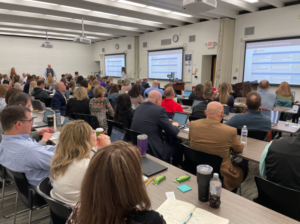Future Superintendents Get Lesson in Leadership

“Everything is more flexible, if I want to learn something, I Google it,” said a school district administrator, “everyone is more independent and less dependant on traditional structures.”
Last week our team had the opportunity to spend the afternoon with a group of talented leaders in Seattle University’s Executive Leadership Superintendent Program. Tom Vander Ark kicked off the spirited discussion about change forces. The administrators noted many of the ways that technology is changing the world, both personally and professionally.
The new 11-month post-masters certificate offered by Seattle University, is designed for experienced professionals with an emphasis on adaptive leadership. The goal of the program is to help educators advance in their fields and become leaders in their districts.
The educators were quick to make the link between the value of technology in their lives and the void of technology in the classroom. They puzzled over budget strategies for boosting access and leadership strategies for motivating innovative uses of technology.
Tom reflected on his experience as a superintendent. (For more on Tom’s leadership reflections see his Good Work series.) According to Tom, “More than any other role, superintendents can change how a community thinks about itself, its children, and its future.” He sketched out a couple bullets of advice:
-
Be visible and transparent,
-
Be a community builder and a conversation leader, and
-
Build a great team that enacts shared values.
“Change leadership takes political capital,” said Tom. “Deposits of political capital take visibility and transparency.”
He also noted that community building is a full-time job, in addition to traditional superintendent responsibilities. The outcomes of community building are capacity, identify, and support.
“It is nearly impossible to pass policies or bonds to improve schools without strong community support,” said Tom. “And, you must communicate a powerful vision and create reliable hope to gain community support.”
To school administrators, tech looks like an add-on expense. “But how can schools afford to do this?,” one educator asked. Over several years, as discuss in Funding the Shift, districts can save money in a couple different categories that help implement improved access to technology.
Tom explained “adaptive software with targeted instruction, such as ST Math, DreamBox, and i-Ready, can actually help save money over time.” Blended models can extend the reach of the best teachers, gives schools the opportunity to leverage great teachers and inform teach teams with real time achievement data. (see Improving Conditions & Careers).
While there is a great opportunity to boost achievement, we’ve all witnessed schools and districts buying tablets with no plan in place on how to use them. We discussed a thoughtful approach to implementing blended learning starting with community conversations that result in clear goals, strong support, and a sound plan.
Disclosures: MIND Research Institute, DreamBox and Curriculum Associates are Getting Smart advocacy partners.






0 Comments
Leave a Comment
Your email address will not be published. All fields are required.